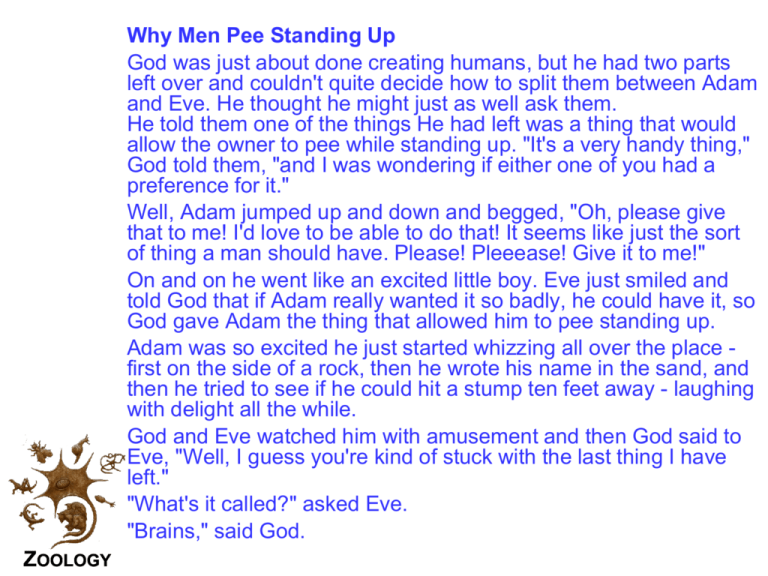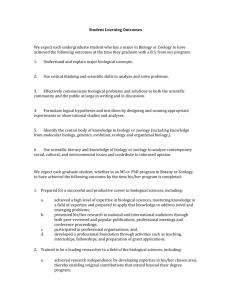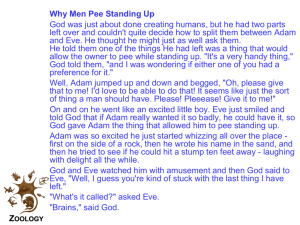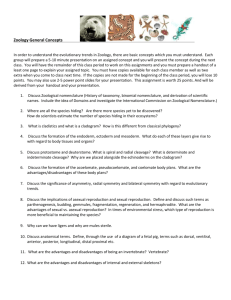BIOL10004-22-2015-gs
advertisement

Why Men Pee Standing Up God was just about done creating humans, but he had two parts left over and couldn't quite decide how to split them between Adam and Eve. He thought he might just as well ask them. He told them one of the things He had left was a thing that would allow the owner to pee while standing up. "It's a very handy thing," God told them, "and I was wondering if either one of you had a preference for it." Well, Adam jumped up and down and begged, "Oh, please give that to me! I'd love to be able to do that! It seems like just the sort of thing a man should have. Please! Pleeease! Give it to me!" On and on he went like an excited little boy. Eve just smiled and told God that if Adam really wanted it so badly, he could have it, so God gave Adam the thing that allowed him to pee standing up. Adam was so excited he just started whizzing all over the place first on the side of a rock, then he wrote his name in the sand, and then he tried to see if he could hit a stump ten feet away - laughing with delight all the while. God and Eve watched him with amusement and then God said to Eve, "Well, I guess you're kind of stuck with the last thing I have left." "What's it called?" asked Eve. "Brains," said God. ZOOLOGY Reproduction Professor Geoff Shaw Department of Zoology g.shaw@zoology.unimelb.edu.au • KLES5: Chapter 20; Chapter 28 esp gonads and HPG axis section pp 693-695, fig 28.11 • KLES4: Chapter 19; Chap 27, esp p 647-648, Fig 27.10 ZOOLOGY Copyright Notice ZOOLOGY Reproduction-Fundamental to life • Reproduction with and without sex • Reproduction and life-history strategies • Structure and function of reproductive systems ZOOLOGY Sexual vs Asexual Reproduction • What is Sex? – A messy mechanism for getting eggs and sperm together… • Asexual reproduction – reproduction without using sperm and eggs ZOOLOGY Sexual Reproduction • • • • Origin of the word “Sex”: Needs two sexes 1350–1400; ME < L sexus “division” “separated” Meiotic cell division Sperm – small, motile Offspring a combination Common strategy among both invertebrates and vertebrates • requires mechanisms to get sperm and egg together fertilization development 4-cell wallaby embryo with sperm ZOOLOGY in egg coats Egg – large, non motile photos by Geoff Shaw Meiosis • Specialised form of cell division – haploid gametes (eggs and sperm) – gametes fuse to form a new diploid individual diploid- 2n zygote haploid- 1n n 2n n fertilization 2n individual germ stem cells 2n male 2n female sperm n n n n n n n meiosis n ZOOLOGY egg Asexual Reproduction • Mitotic cell division • Offspring genetically identical to parents • Common strategy among invertebrates but also seen in some vertebrates budding (eg hydra) regeneration eg starfish cell fission (common in unicellular organisms) ZOOLOGY KLES5 Figs 18.1-3 Variations on a theme… • Hermaphrodites – same individual produces both sperm and eggs – may be able to self-fertilize but common for sperm and eggs to be made at different times – may involve sex-change eg wrasse (see KLES4 19.7) ZOOLOGY Hermaphroditus Variations on a theme… • Parthenogenesis – make egg via meiosis – egg activates and develops without a sperm fertilizing it. eg Aphids ZOOLOGY Reproductive Strategies lots of cheap-to-make offspring given little care few offspring, with heavy investment in development and care ZOOLOGY enough offspring survive to provide next generation Which is best? coral vs human see KLES4 Box 19.4 ZOOLOGY http://www.photolib.noaa.gov/sanctuary/images/big/sanc0417.jpg photo Yves Picq via http://en.wikipedia.org/wiki/ File:Namibie_Himba_0703a.jpg Antechinus – a big bang strategy females juveniles lactation births mating sperm in testes male die off males juveniles month of year ZOOLOGY photos by G Shaw Costs and benefits in reproduction Benefits Mating displays • attracting mates Harems • access to mates external fertilization • physiology simple internal fert’n • make fewer eggs/sperm viviparity • high survival of young post natal care • high survival of young ZOOLOGY Costs • attracting predators • male fighting • high loss of gametes • complex physiology • risk to preg. mother • huge investment by parents Basic design of Reproductive Tracts testis sperm production hormones accessory organs bulk of semen lubrication assist fertilization ZOOLOGY Ovary Ducts convey sperm maturation storage External genitals transfer gametes (eggs and sperm) egg production hormones Ducts convey eggs add protective coats ?sperm and fertilization ?maturation of embryo gonads: testes and ovaries gametes: eggs and sperm ducts: regionally specialised for specific roles genital: relating to the reproductive system external genitals: “naughty parts” male toad urogenital tract fat bodies kidney testis efferent ducts urogenital duct seminal vesicle bladder rectum cloaca ZOOLOGY male mouse reproductive tract kidney fat seminal vesicle vas deferens testis bladder epididymis penis ZOOLOGY prostate (hidden by bladder) Human Male Reproductive Tract Bladder Box 18.1 Vas deferens Seminal vesicle Prostate Epididymis Scrotum Testis (plural: Testes) ZOOLOGY Urethra Penis female toad urogenital tract NOTE: huge number of eggs oviducal funnel oviduct ovary kidney ovisac rectum cloaca ZOOLOGY female mouse urogenital tract utero-ovarian blood vessels fat pad ovary oviduct (Fallopian tube) uterine horn bladder cervix (under bladder) vagina (not visible as it passes through the pelvis) vaginal opening ZOOLOGY kidney Human Female Reproductive Tract Oviduct / Fallopian tube Ovary (Ovaries) Uterus Cervix Egg Vagina ZOOLOGY Box 18.1 Follicle External vs Internal Fertilization • External fertilization. – eg toad – no specialised external genitals needed, but males have nuptial pads on forelimbs to help grasp the female in Amplexus – aquatic environment – usually large numbers of gametes • Internal Fertilization – requires specialization of the external genitalia to allow sperm transfer, eg penis – works in dry environments – needs fewer gametes – prerequisite to viviparity (internal gestation, birth of live young) ZOOLOGY Amplexus Cost: Time and Energy of mating ZOOLOGY behaviour Amplexus: Male holds onto female using special foot pads KLES4 19.26 Other reproductive organs • mammary glands – nutrient transfer in mammals • placenta – nutrient transfer in species with internal development – hormone production • brain – reproductive behaviour – hormone control ZOOLOGY What do I expect you to learn from this lecture? • Reproduction continuation of life • Variety of patterns of reproduction – costs and benefits of different patterns • Asexual reproduction – mitotic; clones; no genetic recombination • Sexual reproduction – meiotic; genetic recombination; unique offspring. – characteristics of eggs and sperm – anatomy of reproductive tracts ZOOLOGY







